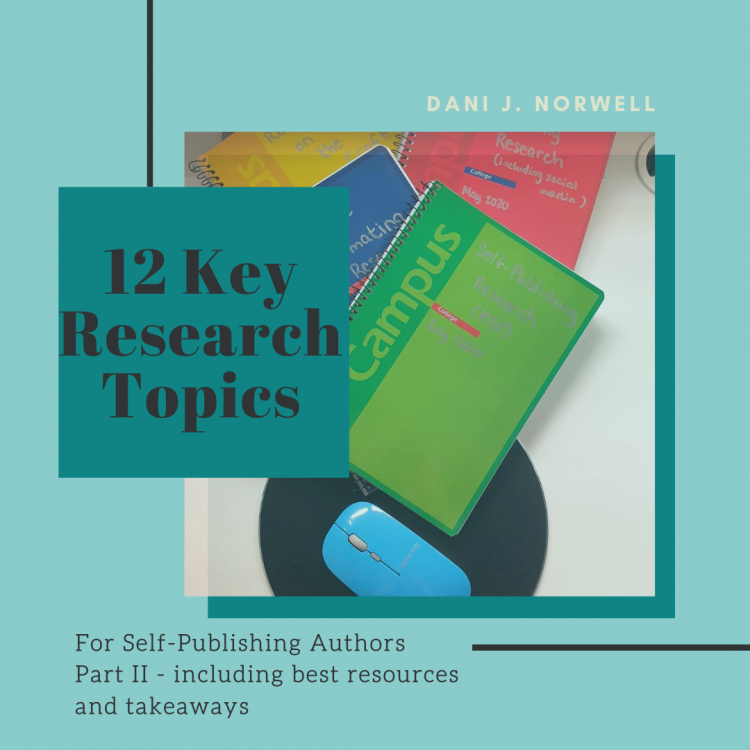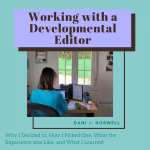What I Researched and You Should Too, continued
And so we’re back, with the second installment of the key topics I researched before publishing for the first time. If you haven’t already read the first half of this list, be sure to read the intro and #1-6 here. Without further ado, let’s jump right into the topics you came for.
7.) Author Name
I’ve included this topic as point #7 because it’s probably not as vital as the other topics in Part I. However, I do believe it’s a topic that you should consider early on in your process. For me, this question of how I wanted to be known as an author was so important that I’ve written an entire other blog post on it (read that here).
Until I started reading up, I didn’t realize there were so many factors that one should keep in mind when it comes to choosing an author name (which can be any variation of your real name or a pen name). This article was the first one I read on the topic and it seems like everyone else who talks about pen names has read it to because you’ll find the example of Allison Potter in almost every resource. Still, it’s worthwhile to get as many opinions as you can on the topic.
If you do decide to use an author name that differs from your legal name in any way, be sure to check out the implications of that and follow the advice given in this Kindlepreneur article about how to set up your KDP profile accurately to avoid any issues with getting paid for your book sales.
8.) Pricing / Promotions:
Choosing the correct listing price for your book and deciding whether or not you will participate in any price promotions is another important topic to consider. A lot of resources advise selling your first book for 99¢ or even for free! It can be a bit disheartening when you realize that, after Amazon (or whatever other marketplace you choose to use to distribute your book) takes their cut, this would leave you with just pennies of earnings (if that).
Others recommend you go the free or 99¢ option for just the first few days, then hike up the price. Others still recommend you not do any sort of price-cutting. There are so many different approaches to this and you really need to decide what you would feel best about so please be sure to consult a variety of source like this, this, and this one. Once you decide what YOU want to do, stand firm in that decision and don’t second-guess yourself.
9.) Marketing:
Along the same lines, the topic of marketing was important for me to understand at a basic level before diving in. That being said, as I mentioned in my Lessons Learned post, I highly recommend setting boundaries for yourself. Do the research, familiarize yourself with the marketing landscape a bit, but ultimately only engage with what you feel good with.
Everyone has different goals. It’s silly to follow the advice of someone who wants to show you how to be a bestseller when all you want to do is get published. I found this list and this resource to be particularly helpful for me. There are plenty of schemes out there to market your book without paying an arm and a leg, so familiarize yourself with the free options too! In the end, the only marketing move I invested any money in was this one.
10.) Social Media:
Speaking of ways to promote your book for free—creating a community is key! I definitely wish I had been on #bookstagram for a few months rather than weeks before launching my book. The reading and writing community is really welcoming and active across almost all social media platforms. I personally opted for Instagram and Goodreads, but I’m told Twitter and YouTube are good places to form connections too!
In the few short weeks of engaging with other #bookstagrammers, I still made enough virtual friends that five accounts (of people I previously did not know) went so far as to share about my new book on Launch Day. I found this amazing, but also realize I could have used these connections sooner in order to recruit more advanced readers and potential reviews and shares.
To learn more about what social media can do for you, start with this blog post. I was personally confused about how to engage with Goodreads as an author (clue: it’s not possible until you can “claim your book,” meaning it must already be published), but this article helped with the details once I was ready.
11.) Mailing List:
I wanted to combine social media and the mailing list into the topic of “forming connections.” However, as I got writing I realized that my research on these topics was done separately for a reason. While it was helpful for me to do a bit of background research before converting my personal Instagram account into a business / author profile, most of what I decided to do there was based on trial and error.
Because social media is public, you can learn a lot from the way other authors are doing it and you can clearly see their methods in action, the overall aesthetics of their feed, and how many people are engaging with what. When it comes to an author newsletter or mailing list, this data is not out there in the open. Thus, I found it really useful to research topics like expert tips for mailing list emails and what to include in an author newsletter (more on that here and here, too). Kindleprenuer’s most recent post on this topic can help you choose the best email service for your needs.
12.) Short story-specific:
I put this topic last, even though it was at the top of my list because there’s a very good chance that you are not writing short stories. However, through my research of almost every other topic, it became apparent to me that the advice about editing, publishing, marketing, etc was generally based on a novel, not a collection of short stories. For this reason, I found it important to look into the particular kind of work I was looking to publishing in order to see in what ways various aspects differed (if they did at all).
Because I did this research later in the game, I missed out on the opportunity to submit my short stories elsewhere before publishing on my own. (Apparently, that is the widely accepted order and you cannot submit short stories to magazines or online journals after publishing a collection together). Thankfully, I still found a number of resources on how to self-publish my own collection here and here, as well as some reasons I might not want to here.
And that wraps up my twelve topics of key importance. To be clear, there were a number of other topics I dedicated some time to including copyright, legal considerations, whether or not I needed an ISBN, and creating an author website. However, at least as a first time self-publishing author, none of these topics weighed as heavily on my decisions as the twelve listed and explained above. By all means, please do that research too, but I would personally recommend starting in the top dozen.
Anything else you researched and found essential (or wish you hadn’t wasted so much time on)? Let me know in the comments below!


1 thought on “12 Key Research Topics For Self-Publishing Authors (Part II)”